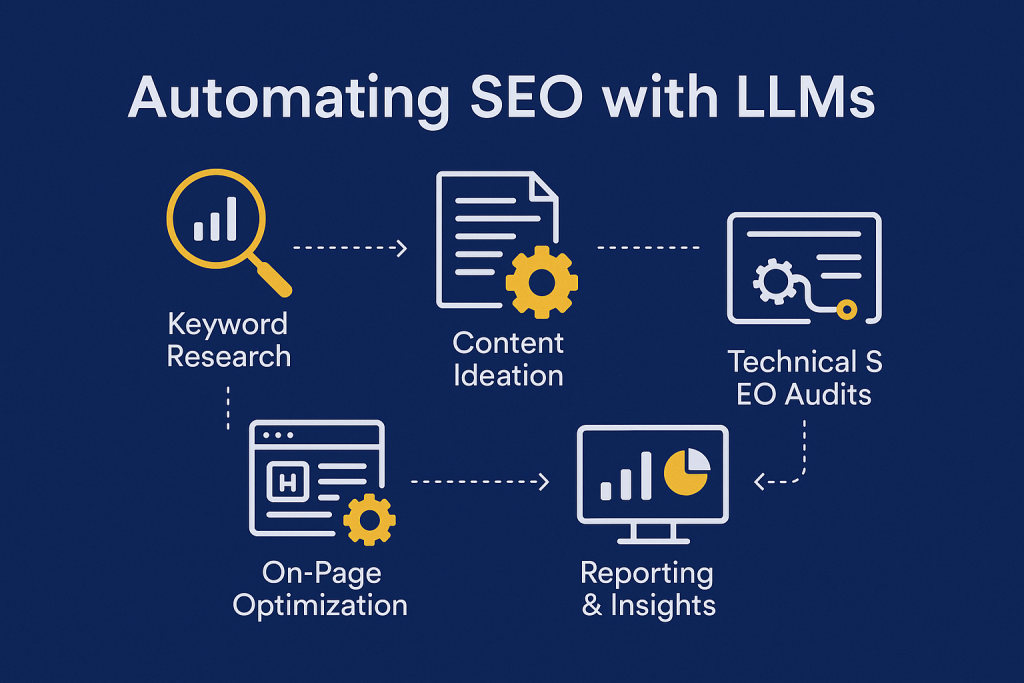
Automating SEO with LLMs: Streamline Keyword Research & Content
Search Engine Optimization (SEO) has undergone a seismic shift with the advent of large language models (LLMs). What once relied on manual keyword research, content ideation, and link-building now can be streamlined by AI-powered workflows. As search engines evolve—incorporating generative AI summaries and “answer engines” that provide direct responses—marketers must harness LLMs not only to keep pace, but to get ahead in visibility and efficiency.
Why Automate SEO with LLMs?
- Scalability: LLMs can analyze millions of keywords, search snippets, and competitor pages in minutes—tasks that would take a human team weeks.
- Speed: From drafting outlines to generating meta descriptions, AI cuts content production time dramatically.
- Data-Driven Insights: By synthesizing search intent signals and SERP features, LLM‐powered tools recommend optimizations grounded in real-time data
Core Automation Use Cases
Keyword Research & Clustering
- LLMs parse search queries, grouping related keywords into topical clusters.
- Tools like Gumloop automate the extraction of high‐value keywords and long-tail variants at scale.
Content Ideation & Outline Generation
- Provide a seed keyword or topic; LLMs generate detailed blog structures with H2/H3 suggestions.
- Surfer AI and ChatGPT plugins can draft outlines tailored to user intent, ensuring coverage of semantic subtopics.
On-Page Optimization
- LLMs audit existing pages for missing keywords, content gaps, and readability.
- Alli AI integrates with popular CMS platforms to auto‐inject optimized headings, internal links, and schema markup.
Technical SEO Audits
- Automated crawling bots powered by n8n or custom AI agents identify broken links, redirect chains, and page‐speed issues.
- LLMs interpret log data to prioritize fixes that will have the greatest impact on crawlability and indexation.
Automated Reporting & Insights
- Looker Studio dashboards, fed by AI‐parsed Search Console and Analytics data, generate weekly insights and anomaly alerts.
- AI summarization engines craft executive reports highlighting key wins, losses, and action items.
Emerging Trend: Answer Engine Optimization (AEO)
As generative AI interfaces (e.g., ChatGPT, Google Bard) replace traditional search results, “Answer Engine Optimization” focuses on crafting content that conversational AIs surface in their direct answers. Rather than targeting a single keyword, AEO emphasizes comprehensive, authoritative coverage of question clusters—ensuring your brand’s expertise is cited in AI responses.
Best Practices & Ethical Considerations
- Maintain Human Oversight: Always review AI‐generated content for factual accuracy, tone alignment, and brand consistency.
- Avoid Spam Signals: Search engines are cracking down on low-value AI spam. Prioritize original insights and human‐verified data to sidestep penalties.
- Transparent Attribution: If your content leverages AI research or summaries, be upfront about your methodology to build trust.
Real-World Example: Adapting to AI-Driven Search
Companies like Intuit Mailchimp have reported traffic declines as more users complete searches directly within AI interfaces rather than clicking through to sites. In response, they’ve shifted toward GEO (Generative Engine Optimization) and AIO (Artificial Intelligence Optimization) tactics—structuring content for machine readability and fast‐loading, API-style endpoints that AI assistants can easily ingest.
Automating SEO with LLMs is no longer optional; it’s essential. By leveraging AI for research, creation, optimization, and analytics, marketers can reclaim strategic bandwidth, focus on high-impact initiatives, and stay visible in both traditional and AI‐driven search environments. As generative interfaces proliferate, the next frontier will be real-time content personalization and dynamic SEO pipelines that adapt to user behavior instantly. Embracing LLM automation today lays the foundation for tomorrow’s search landscape.